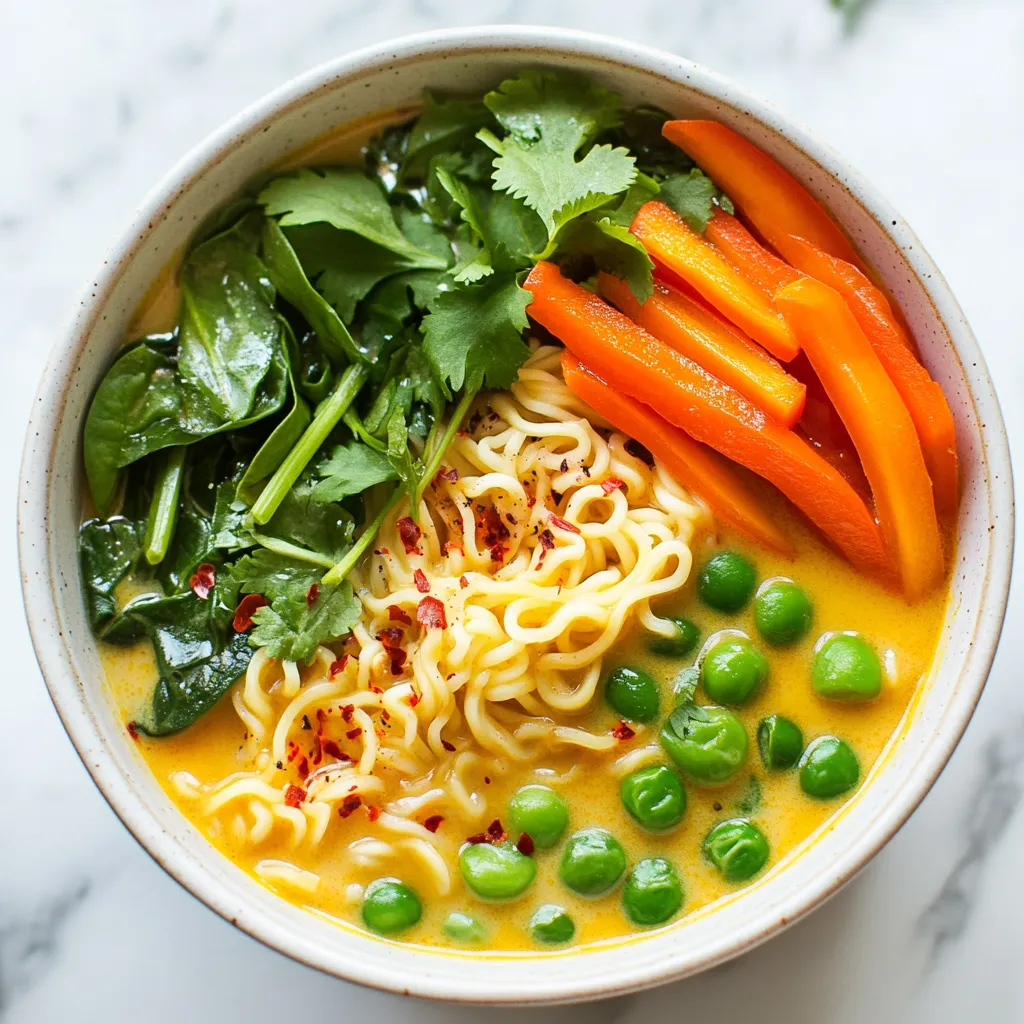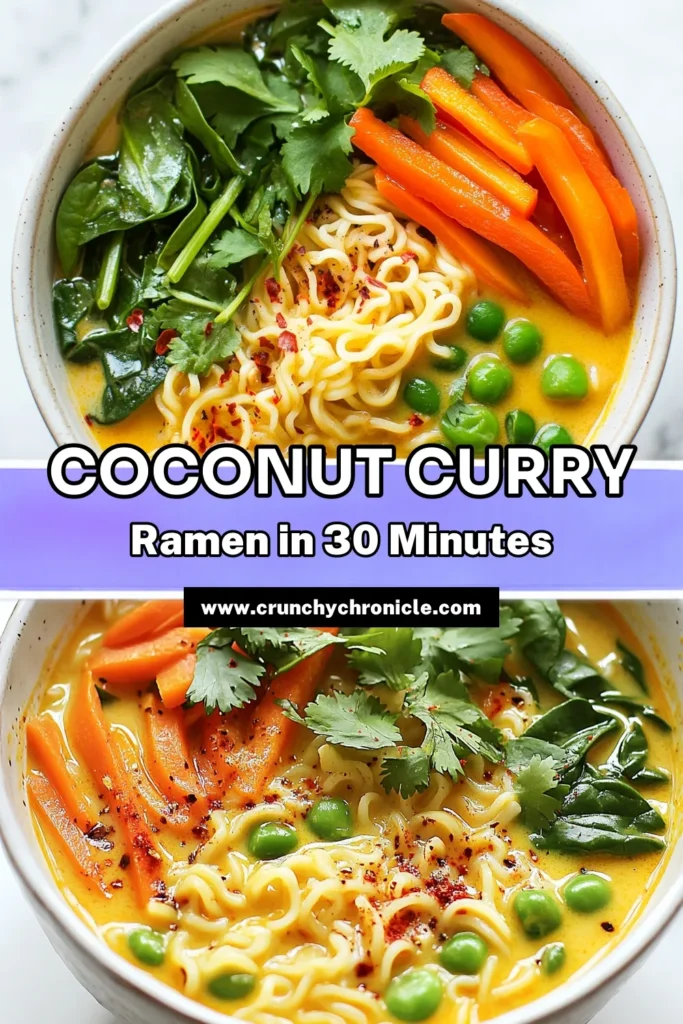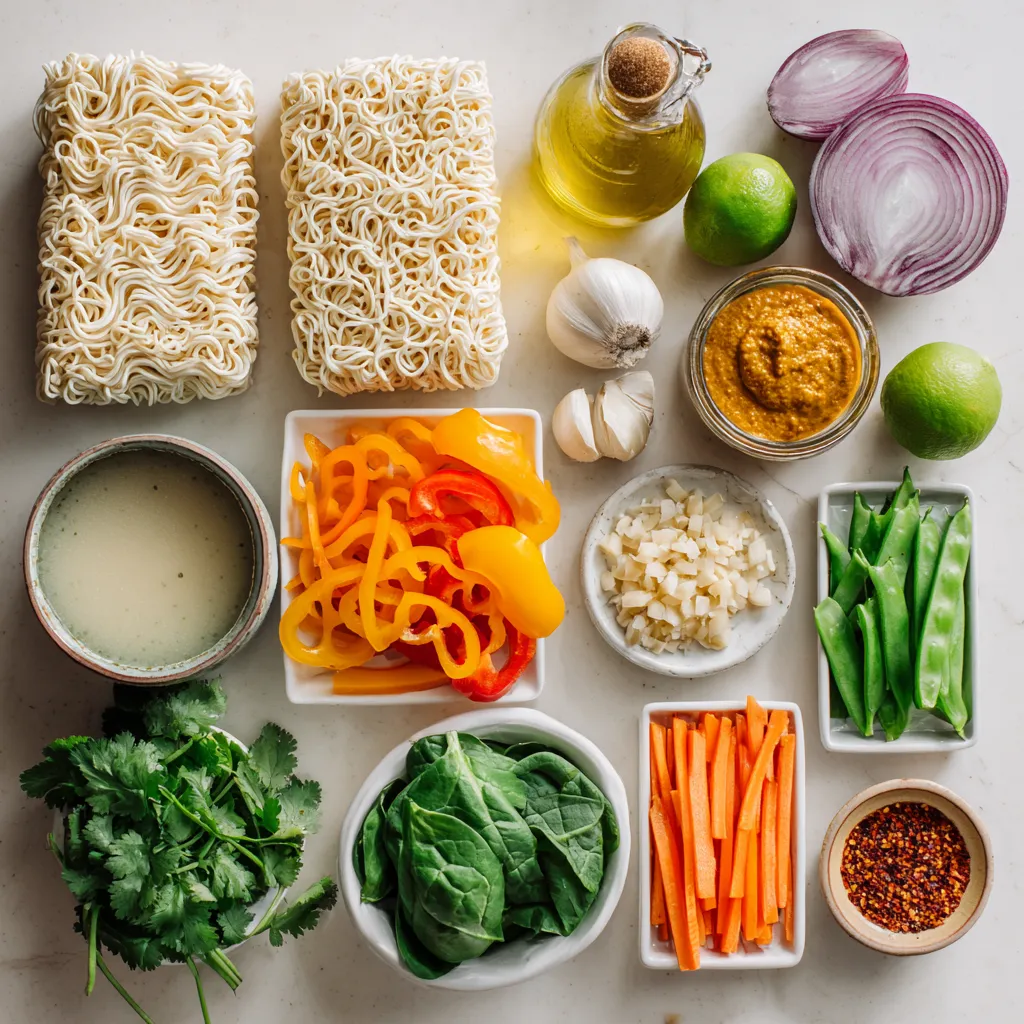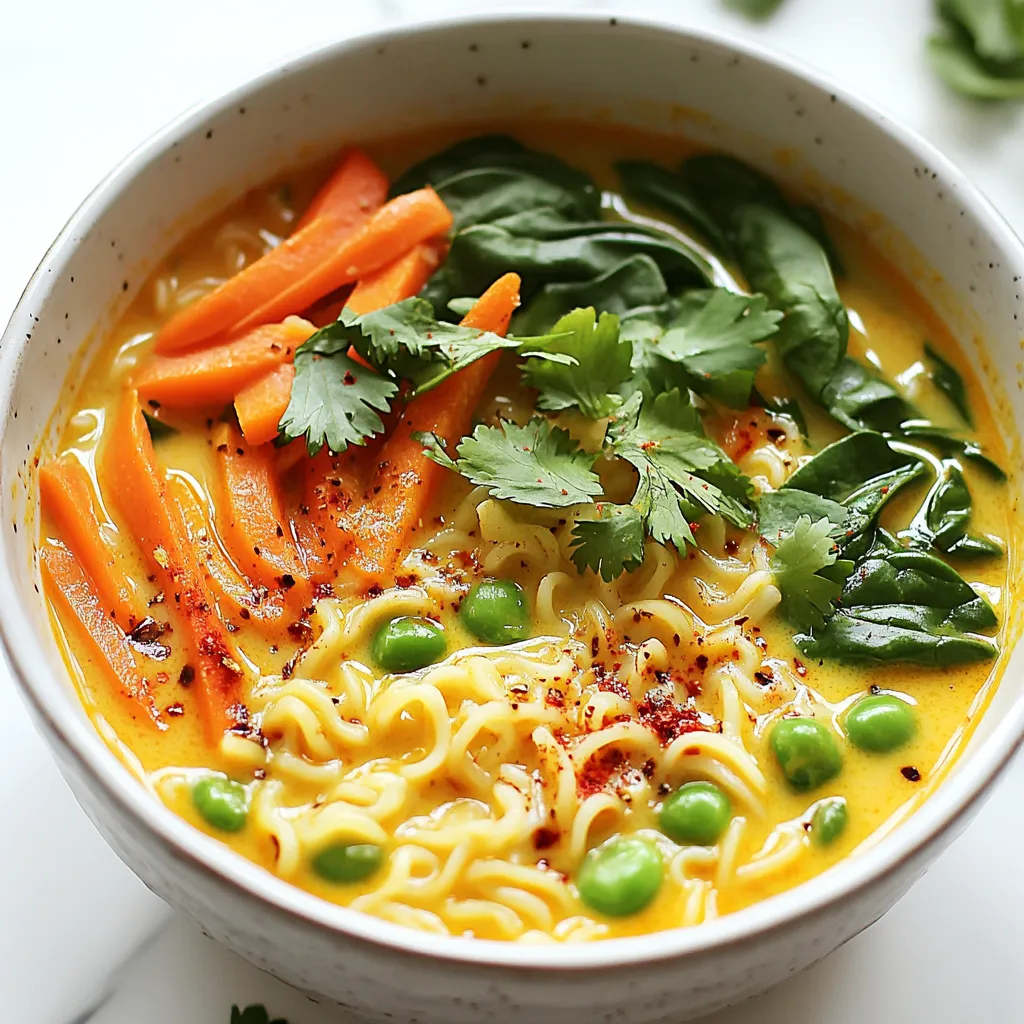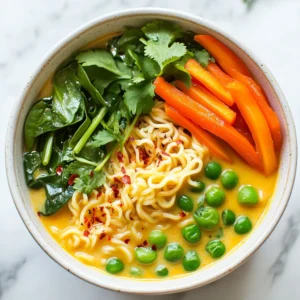WANT TO SAVE THIS RECIPE?
Looking for a warm, cozy meal that bursts with flavor? Try my Coconut Curry Ramen Bowl! This dish combines spicy curry, rich coconut milk, and your favorite ramen noodles for a comforting bowl. Packed with vibrant veggies and aromatic herbs, it’s perfect for any night. Let’s dive into the magic of this simple recipe that will leave you feeling happy and full. Your taste buds will thank you!

Why I Love This Recipe
- Comforting and Creamy: This ramen bowl combines the rich creaminess of coconut milk with aromatic spices, creating a warm and comforting dish that feels like a hug in a bowl.
- Quick and Easy: With a prep time of just 15 minutes and a total cooking time of 30 minutes, this recipe is perfect for busy weeknights when you want something delicious without spending hours in the kitchen.
- Customizable: You can easily swap out vegetables based on what you have on hand or your personal preferences, making this recipe versatile and adaptable to different tastes.
- Healthy and Nutritious: Bursting with colorful vegetables and packed with nutrients, this coconut curry ramen bowl is not only delicious but also a healthy option for a satisfying meal.
Ingredients
Essential Ingredients for Coconut Curry Ramen Bowl
To make your Coconut Curry Ramen Bowl, gather these essential ingredients:
– 2 packs of ramen noodles (discard the seasoning packets)
– 1 can (13.5 oz) full-fat coconut milk
– 2 cups vegetable broth
– 2 tablespoons curry paste (red or yellow)
– 1 tablespoon olive oil
– 1 medium onion, thinly sliced
– 2 cloves garlic, finely minced
– 1-inch piece of fresh ginger, grated
– 1 bell pepper, thinly sliced
– 1 cup snap peas or green beans, trimmed
– 1 large carrot, julienned
– 1 cup baby spinach, rinsed and drained
– 2 tablespoons soy sauce (or tamari for gluten-free)
– Juice of 1 fresh lime
– Fresh cilantro, chopped, for garnish
– Crushed red pepper flakes (optional)
These ingredients combine to create rich flavors and a warm, comforting meal.
Optional Ingredients for Enhanced Flavor
You can add these optional ingredients to boost the flavor:
– Chopped green onions for freshness
– Sliced chili peppers for extra heat
– Toasted sesame oil for a nutty touch
– Mushrooms for an earthy flavor
– Peanuts for crunch and texture
These ingredients allow you to customize your bowl to suit your taste.
Ingredient Substitutions (Gluten-free, Vegan, etc.)
If you have dietary restrictions, here are some great substitutions:
– Use gluten-free ramen or rice noodles instead of regular ramen.
– Replace soy sauce with coconut aminos for a soy-free option.
– For vegan options, ensure the curry paste is plant-based.
– Swap vegetable broth with homemade broth for better flavor.
These substitutions make it easy to enjoy this dish without compromising your diet.

Step-by-Step Instructions
Preparation of Aromatics (Onion, Garlic, Ginger)
Start by heating olive oil in a large pot over medium heat. Add the thinly sliced onion and sauté for about 3 to 4 minutes. You want the onion to become soft and clear. Next, add minced garlic and grated ginger to the pot. Cook them together for 1 to 2 minutes. Stir well to keep them from burning. The smell will be amazing!
Cooking the Curry Base with Coconut Milk
Now, it’s time to make the curry base. Add your choice of curry paste to the onion mix. Stir it well so the onions are coated. Let it cook for about 2 minutes to deepen the flavor. Gradually pour in the can of coconut milk and the vegetable broth. Mix until the curry paste blends in completely. Bring this mixture to a gentle simmer.
Adding Vegetables to the Broth
While your broth simmers, it’s time to add some color and crunch! Mix in the sliced bell pepper, snap peas, and julienned carrot. Allow these vegetables to cook for 5 to 7 minutes. You want them to stay bright and slightly crisp. This adds great texture and freshness to your dish.
Cooking Ramen Noodles
In a separate pot, bring water to a boil. Cook the ramen noodles according to the package instructions, usually about 4 to 5 minutes. Once they are done, drain them and set aside. It’s important not to overcook them, as you want the noodles to hold their shape in the bowl.
Assembling the Coconut Curry Ramen Bowl
Now comes the fun part—assembly! Place a portion of the cooked ramen noodles at the bottom of each bowl. Ladle the coconut curry broth and the vibrant vegetables over the noodles. Finish it off by garnishing with freshly chopped cilantro. For a spicy kick, add a pinch of crushed red pepper flakes. Enjoy your delicious bowl of comfort!
Tips & Tricks
Tips for Perfectly Cooked Ramen
To make your ramen just right, follow these tips:
– Use fresh ramen noodles. They cook faster and taste better than dried ones.
– Boil water in a separate pot. This keeps the noodles from getting mushy.
– Cook the noodles for 4-5 minutes. Check the package for exact times.
– Drain them but do not rinse. Keeping the starch helps the sauce stick.
These steps will give you a chewy and satisfying ramen base.
Enhancing Flavor with Spices and Herbs
To boost flavor, try these ideas:
– Use fresh herbs like cilantro and basil. They add brightness to your bowl.
– Add a squeeze of lime juice for zest. This brightens the curry’s richness.
– Include crushed red pepper flakes for heat. Adjust the amount to your taste.
– Experiment with different curry pastes. Red paste is spicier, while yellow is milder.
Mixing these elements can create a unique taste that you’ll love.
Presentation Tips for Serving
How you serve your ramen can make it feel special:
– Use large, rustic bowls. They add a cozy, homey vibe.
– Layer the noodles first. Then, add the curry and veggies on top.
– Top with fresh cilantro. A sprinkle adds color and freshness.
– Consider using lime wedges on the side. It invites guests to add their own zest.
These simple tips will make your dish look as good as it tastes.
Pro Tips
- Choose Your Curry Paste Wisely: The flavor profile can greatly change based on the type of curry paste you choose. Red curry paste typically has a bolder flavor, while yellow curry paste is milder and sweeter. Adjust according to your preference!
- Don’t Overcook the Vegetables: Aim to keep your vegetables slightly crisp to enhance texture and retain nutrients. Add them at different stages of cooking if you prefer varying textures.
- Customize Your Protein: This bowl is versatile! Feel free to add tofu, shrimp, or chicken for added protein. Just ensure to cook it thoroughly before adding to the broth.
- Garnish for Extra Flavor: Fresh herbs like cilantro and a squeeze of lime juice not only add vibrant color but also enhance the flavor profile. Don’t skip this step for a delicious finish!

Variations
Vegetarian and Vegan Options
You can easily make this dish vegetarian and vegan. The main ingredient to watch is the broth. Just use vegetable broth. This makes the dish light and fresh. You can also swap the soy sauce for tamari to keep it gluten-free. Add more veggies like mushrooms or zucchini to enhance the flavor. They add texture and taste. Consider using tofu for added protein. Tofu absorbs flavors well, making it a great choice.
Different Types of Curry Paste
Curry paste adds depth to coconut curry ramen. You can choose red or yellow curry paste. Red curry paste is bold and spicy. Yellow curry paste is milder and slightly sweet. Each type brings unique flavors. You can also try green curry paste for a fresh twist. Each one changes the dish, so feel free to experiment. Use the one that matches your taste best.
Noodle Alternatives
Ramen noodles are delightful, but you can switch them out. Rice noodles offer a gluten-free option. They soak up the broth’s flavor well. Udon noodles are thick and chewy. They add a different texture to the dish. Soba noodles, made from buckwheat, are another great choice. They provide a nutty flavor and are also gluten-free. Don’t be afraid to try different noodles to find your favorite!
Storage Info
How to Store Leftovers Properly
To keep your coconut curry ramen fresh, place leftovers in an airtight container. Store it in the fridge. This will keep the flavors intact for about three days. If you have extra noodles, store them separately. This prevents them from getting soggy in the broth.
Reheating Instructions for Best Quality
When you are ready to enjoy your leftovers, reheat the ramen gently. Pour the curry broth into a pot and heat over medium-low heat. Stir to warm it through. If the noodles are separate, add them toward the end. This will keep them from overcooking. You can also use a microwave. Place the ramen in a bowl, cover, and heat in short bursts. Stir between each burst.
Freezing Tips for Long-Term Storage
If you want to freeze your coconut curry ramen, do this before adding fresh veggies or noodles. Place the curry broth in a freezer-safe container. Label it with the date. This meal can last up to three months in the freezer. To eat, thaw it overnight in the fridge. Then, reheat as described above. When ready, cook fresh noodles and add them to your thawed curry for a delicious meal.
FAQs
What can I substitute for coconut milk?
You can use almond milk or soy milk in place of coconut milk. These alternatives change the flavor. If you want a creamy texture, try cashew cream. You can make cashew cream by blending soaked cashews with water.
Can I make coconut curry ramen in advance?
Yes, you can prepare it ahead of time. Cook the broth and add the veggies. Store the ramen noodles separately. When ready to eat, just combine them. This keeps the noodles from getting soggy.
How can I make this dish spicier?
To spice up your ramen, add more curry paste. You can also use crushed red pepper flakes. Another option is fresh chili slices. Taste as you go, so it doesn’t get too hot.
What are the best toppings for coconut curry ramen?
Great toppings include sliced green onions, fresh cilantro, or lime wedges. You can also add avocado slices or a soft-boiled egg. Toasted sesame seeds add a nice crunch too.
Where to find coconut curry ramen at restaurants?
You can find coconut curry ramen at many Asian fusion restaurants. Look for places that serve ramen or Thai food. Some trendy spots may even have creative variations on the dish.
In this post, I covered how to make a delicious coconut curry ramen bowl. I shared essential ingredients, ways to enhance flavor, and tips for cooking the perfect noodles. I also discussed presentation and how to store your ramen.
Remember, you can swap ingredients easily for gluten-free or vegan options. This dish is fun and flexible. I hope you enjoy making your own unique bowl of coconut curry ramen. Happy cookin
Coconut Curry Ramen Bowl
A vibrant and creamy ramen bowl featuring coconut milk and fresh vegetables, perfect for a comforting meal.
Prep Time 15 minutes mins
Cook Time 15 minutes mins
Total Time 30 minutes mins
Course Main Course
Cuisine Asian
- 2 packs ramen noodles (discard the seasoning packets)
- 1 can (13.5 oz) full-fat coconut milk
- 2 cups vegetable broth
- 2 tablespoons curry paste
- 1 tablespoon olive oil
- 1 medium onion, thinly sliced
- 2 cloves garlic, finely minced
- 1 inch piece of fresh ginger, grated
- 1 bell pepper thinly sliced (any color for vibrancy)
- 1 cup snap peas or green beans, trimmed
- 1 large carrot, julienned
- 1 cup baby spinach, rinsed and drained
- 2 tablespoons soy sauce (or tamari for gluten-free option)
- 1 juice of fresh lime
- to taste fresh cilantro, chopped, for garnish
- optional crushed red pepper flakes
Begin by heating the olive oil in a large pot over medium heat. Once warm, add the sliced onion and sauté for about 3-4 minutes until it becomes translucent and softened.
Add the minced garlic and grated ginger to the pot, cooking for another 1-2 minutes until aromatic, stirring frequently to prevent burning.
Incorporate the curry paste into the mixture, stirring well to coat the onions, and let it cook for 2 minutes to deepen the flavors.
Gradually pour in the coconut milk and vegetable broth, mixing until the curry paste is fully integrated. Bring the mixture to a gentle simmer.
As the broth simmers, mix in the sliced bell pepper, snap peas, and julienned carrot. Allow the vegetables to cook for 5-7 minutes, keeping them vibrant and slightly crisp.
In a separate pot, bring water to a boil and cook the ramen noodles per the package instructions (usually about 4-5 minutes). Once done, drain the noodles and set aside.
Stir the baby spinach into the coconut curry broth, followed by the soy sauce and freshly squeezed lime juice. Mix until the spinach wilts down substantially.
To assemble each bowl, place a portion of ramen noodles at the bottom, then ladle the coconut curry and assorted vegetables generously over the noodles.
Finish by garnishing each bowl with freshly chopped cilantro and a pinch of crushed red pepper flakes, if you want extra heat.
Serve in large, rustic bowls for a homey feel. Brightly colored floral or green garnishes will enhance the visual appeal.
Keyword coconut curry, comfort food, ramen, vegetarian
WANT TO SAVE THIS RECIPE?
